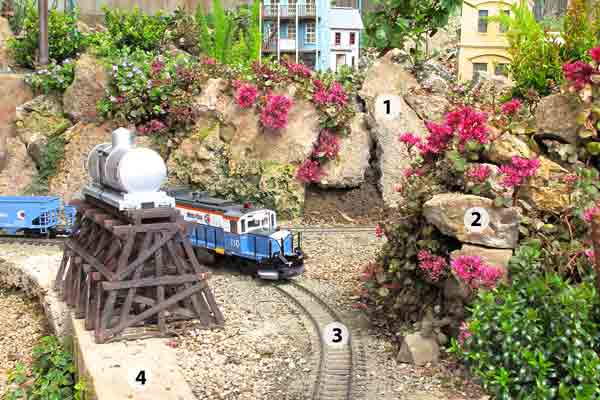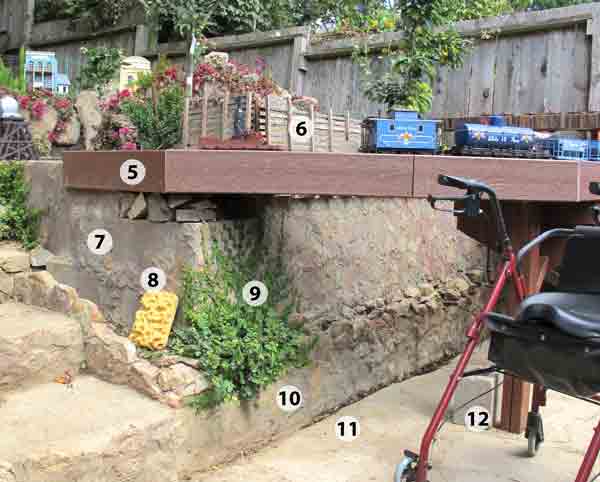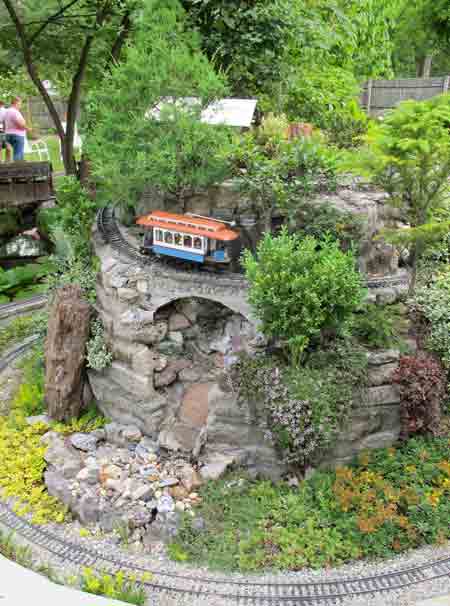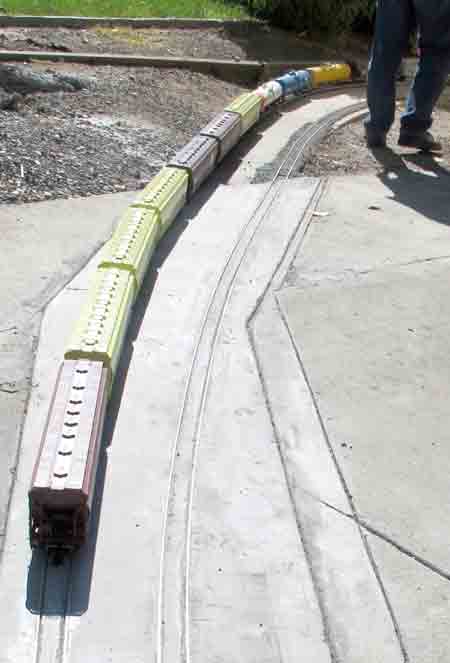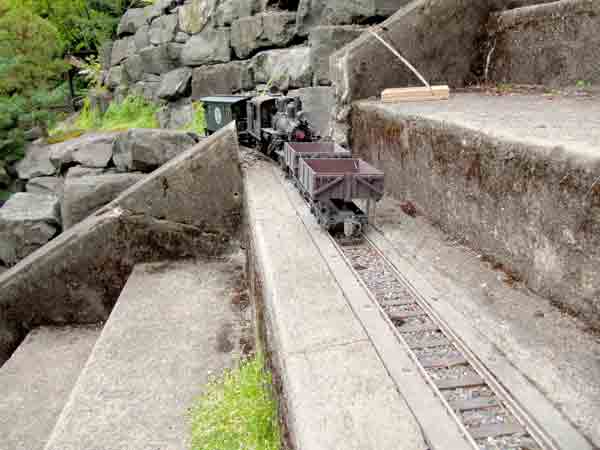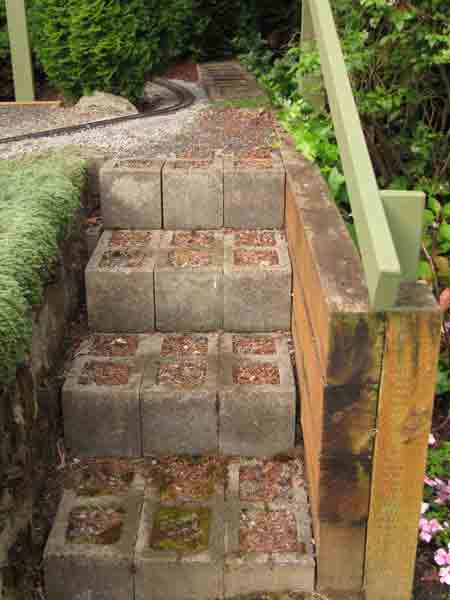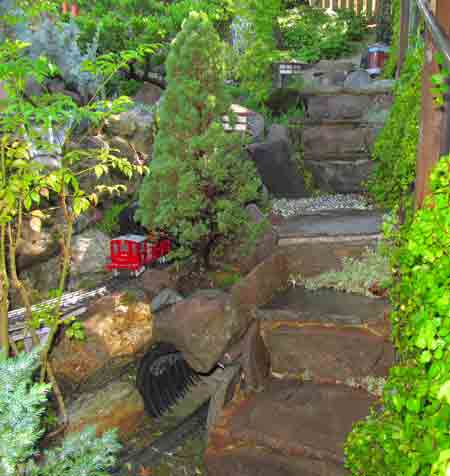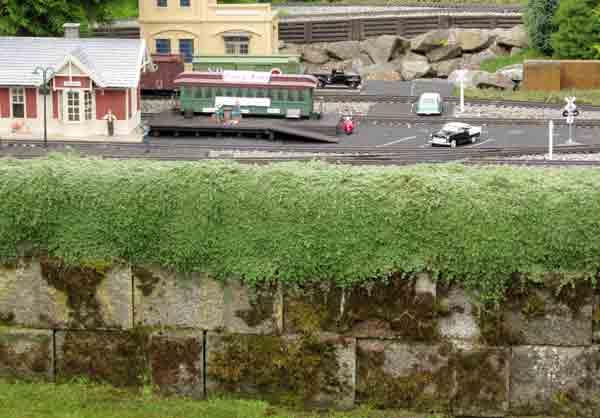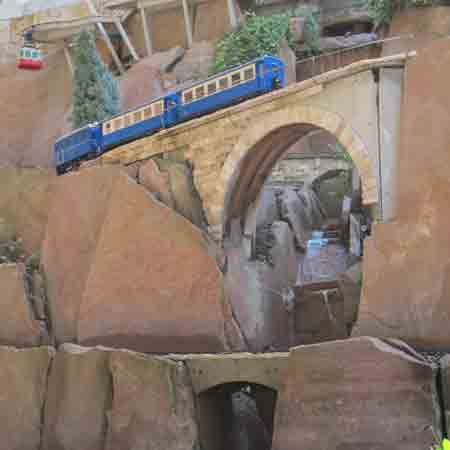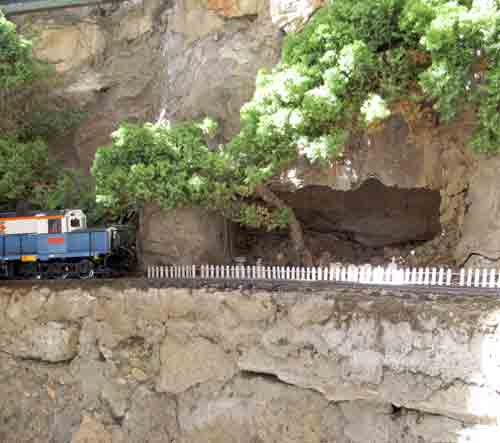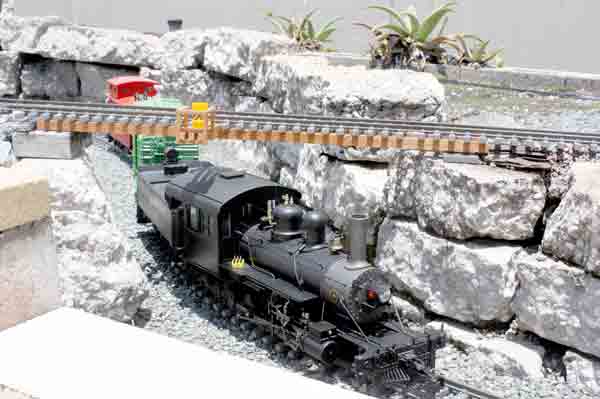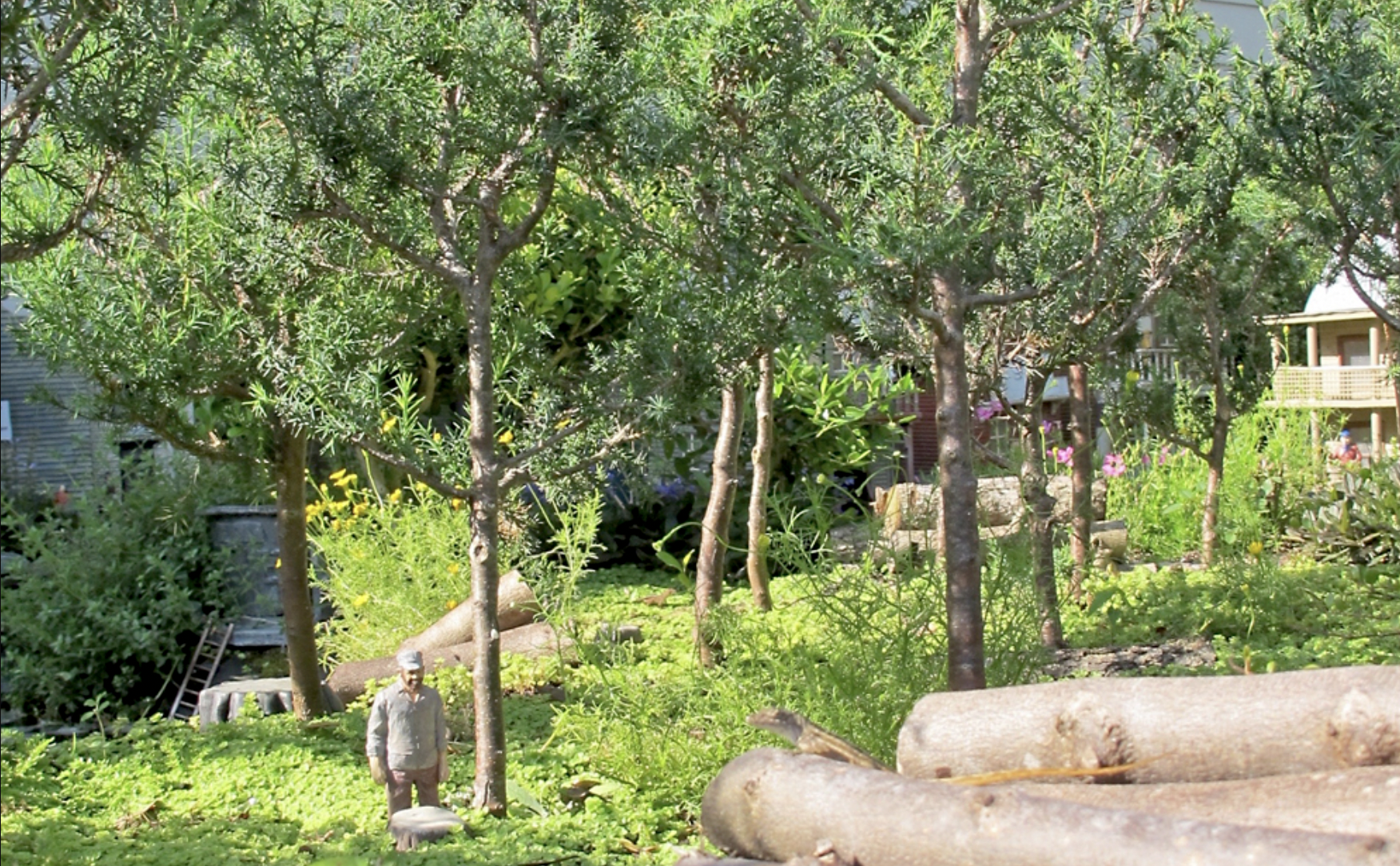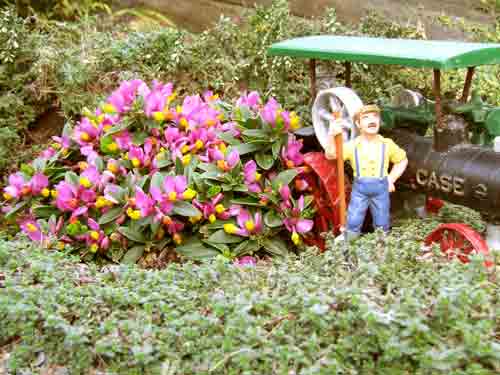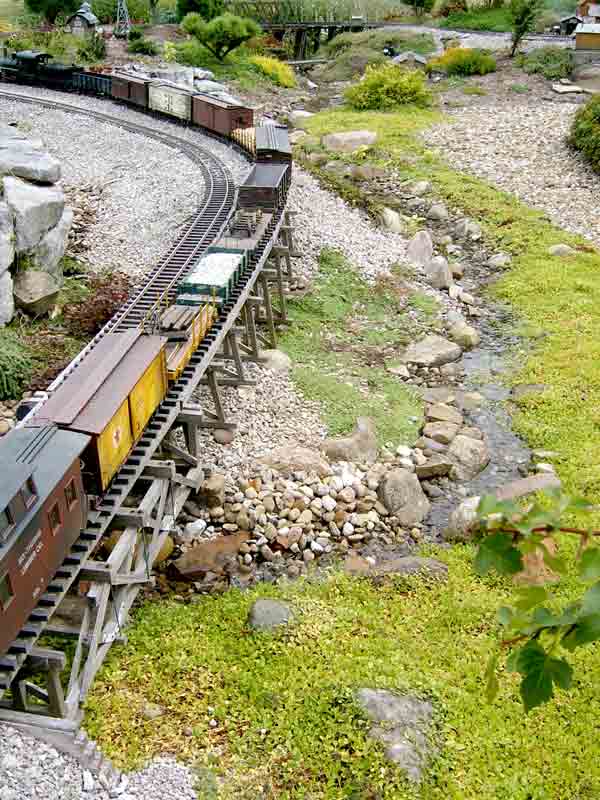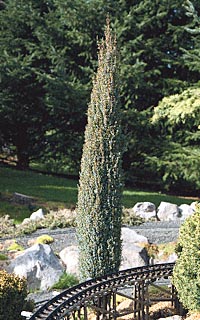s an inexpensive alternative to natural stone, cement products can form secure walls and surfaces for railroads, plantings, and access areas. Some uses for concrete hardscape include grade changes for the railroad, solid steps, and sub-roadbed for track that can be walked on. You can easily stack concrete blocks or cast your own shapes from concrete mix. This issue’s look at cement products introduces various applications for your outdoor railway, followed by tips that will help the hardscape appear more like natural stone.
Recycled concrete chunks
Last year I built the MVP Railroad into a steep hill. It was already terraced with old concrete, full of weeds and irregular grades (from San Francisco’s earthquakes, no doubt). I left the central steps (edged in real stone) in place but we needed a railroad loop on one level (photo 1). A big consideration for this railroad required easy access for the owner/operator, Edward Van Pelt, who gets around in a wheelchair or walker. To raise terraces, we built up block walls or mountains. To lower terraces, we cut out sections of concrete with an angle grinder, sledgehammer, and pry bar.
We chose to reuse the 70-year-old concrete. When turning over some large pieces, we could see pebbles stuck to the underside, and decided to recycle the concrete for three purposes. We first needed a patio at the bottom where Edward could reach a good portion of the dogbone track (photo 2). Next, we stacked concrete bits to form three mountains, later planted with sedum. Finally, we needed to steeply raise the grade for a point-to-point line, which crosses over the lower loop. On the far side, leaning-concrete cliffs retain the soil and take up little space in this small yard. Although we carried many bags of concrete mix, mortar, and blocks up the flight of stairs, we did not have to carry up any boulders.
We kept some of Edward’s original mortared stone walls in place to shorten the project and reduce the expense. Similarly, in photo 3, Tom and Therese Elliott saved on materials by mortaring together concrete pieces for a charming helix, with plenty of planting places and a formed-concrete arch bridge over a rock fall.
A dozen ways to use cement products in the railway
Please refer to the numbered examples in photos 1 and 2.
1. Recycled cliffs. After breaking up old walkways and patio, turn over the concrete chunks. Wash them with a hose, then sponge or spray on paint to help the concrete match native stone. Overlap the edges to prevent erosion and add visual depth to the cliffs.
2. Recycled walls. Clean up and stack chunks of old concrete, exposing the most textured sides. Each piece should slope down into the dirt to retain water and soil. Paint, if desired (see #9 below). Grow plants in the spaces to prevent erosion.
3. Concrete block sub-roadbed. Beneath the track, during grading, leave room for two-hole contiguous concrete blocks (8″ x 8″ x 16″). Here, the blocks have been leveled and filled with concrete mix. Once the track placement is finalized, the DG (decomposed granite) ballast can be glued with Concrete Bonding Adhesive (a Quikrete product). This track is stepable.
4. Retaining walls. In a 2-4″ trench filled with drainage rock, level a row of staggered two-hole concrete blocks (8″ x 8″ x 16″) so they lean slightly into the proposed hill. Never build walls over three feet high without professional help. Backfill with dirt or drainage rock. Hammer rebar (steel reinforcing bar) into every other cavity of the blocks. Fill holes with dry concrete mix then add enough water to moisten it while pushing it in with an extra rebar. Alternatively, moisten the concrete mix before pouring into holes.
5. Support for benchwork. Before filling concrete-block walls, secure a vertical post of lumber or metal down into one of the holes, leaving the top of the vertical exposed at least 3″. Fasten horizontal benchwork beams to the verticals.
6. Faux retaining walls or cribbing. To add a scale feature to the top of a block retaining wall, glue and nail scale lumber onto a 1″ or 11/2″ board that’s 4-8″ wide (high). Apply glue (I use Loctite PL Premium polyurethane construction adhesive) to the back side of the board and stick it to the top edge of the wall, which has dry, clean blocks. Clamp the board to the blocks for a day or two.
7. Hide the blocks in plain sight. Disguise blocks by applying mortar to the cracks. First, moisten the blocks and (preferably) brush or spray with Concrete Bonding Adhesive to accept the mortar. Trowel peanut-butter-consistency moistened mortar in diagonal patterns to get rid of the man-made horizontal and vertical cracks. Don’t smooth it.
8. Sponge on color. On a concrete wall with the cracks covered (#7), first use a dry paintbrush to apply powdered black tempera paint, which settles in crevices when misted with water. Select several colors of concrete paint or stain that are compatible with the landscape. With a sea sponge or a big distressed work sponge, apply one color at a time in patches, preferably working light to dark, although you can go back over the wall again.
9. Planting gaps. Plan to leave gaps in the concrete work for gardening. Most vines with holdfasts like to climb up but trailing plants like to hang down.
10. Mortar real stone or concrete pieces. In the pictured example, we kept the 70-year-old retaining wall of native stone, which had been fastened by applying mortar in brick-laying fashion. (See tips below on mortar application.)
11. Patios and walkways. Measure the depth of your thickest piece of old concrete and dig a level base to exceed that depth. Next, add a layer of drain rock or base fines. Place each piece of old cleaned-and-wetted concrete, smooth side up, on moistened concrete over the gravel. Use a long level to be sure the tops form a uniform surface, sloped slightly for drainage, then smooth moistened concrete mix between the concrete “flagstones.”
12. Walking-stick holder. A walking stick does no good lying on the ground, so Edward made a holder. His cane is always in reach when he parks it in a one-hole concrete block under the benchwork.
More hardened roadbed
How did Bob Ferguson get the double mainline of his Tired & Ambitious Railroad to encircle his house? Masonry! He cut out a section of his concrete driveway and filled the gap with rails held at the correct gauge by smoothed concrete. It’s drive-able (photo 4). Marshall and Weylin Rose needed to get their trains over their concrete stairs, but still allow for safe foot traffic. On their Triple Falls Lumber & Mining Company they cut out the retaining wall on both sides of the steps, then cut out a section of one step, and finally inserted the track between narrow boards screwed into the step (photo 5).
In the April 2013 GR, “Greening your railway: How we promote the hobby through teamwork,” is a link to a 30-step slide show on how to build hardened sub-roadbed using gravel, concrete blocks, and stucco/sand ballast. View that slide show online.
No-stumble steps
To build outdoor steps “to code” means that the risers and stair treads are uniform. Fred and Bonnie Konkel’s stairs of stacked concrete blocks are safe because each riser is the same height and each tread is the same depth (photo 6). To get the steps to blend with the moss-rock boulders of the Jim and Jackie Ditmer’s Osaka & Orient Express, I took the concrete-block steps “one step further” by hiding the blocks with thin flagstones mortared in place (photo 7).
Tips for hiding cement products
The white-gray color, flat-smooth finish, and manmade horizontal/vertical lines of cement products may be clean looking, but not gardeny. Nature is perfect, but not in a sterile, geometrical pattern. To modify the color before mixing mortar or concrete, add colorings (found in the masonry section of the store) of green, buff, red, brown, or black. I like a brown/black blend when mortaring rocks to a water feature because it looks like dirt. Rock yards also sell tan-colored mortar. To modify the color of mortar or concrete after it sets up, use a spray bottle with a slurry of iron sulfate (it doesn’t matter how strong it is) to spray on fresh cement products so that the gray turns rusty.
The Konkels illustrate three other ways to blend and hide concrete blocks in a wall (photo 8). Start with blocks that have a colored, textured finish. Spray them with vinegar to lower the high (alkaline) pH. This chemical process speeds up the natural leaching that would occur over time with water alone and allows mosses to get a foothold. Finally, plant on top of the wall so that stems trail down and soften the hard edges.
Cement products can also help you create more planting places. It’s easier to make your walls secure and they go up faster than stone walls.
One last tip—barely moisten your cement products. Soupy isn’t strong. Read the product instructions, allow the finished work to cure slowly, and keep it moist for full strength.
Cement board
A list of cement products for garden railways should include cement board, such as HardieBacker board, which is available in various thicknesses and strengths. Waterproof decking for benchwork is easy—just score the board 5-6 times along your cut line with a utility knife, break it over the edge of a bench or a row of blocks, and screw it into your frame. Paint on concrete bonding adhesive sprinkled with fines (decomposed granite, chicken grit, etc.) to hide the cement and ballast your track. Or better, ballast the track and sprinkle on the adhesive mixed with water, 1:2 or 1:3.
Bobby Waal used cement board for bridges. After framing the opening with redwood, he screwed on the base for an arch bridge. Photo 9 shows three such bridges in different phases of completion for his alpine railway. Thinset mortar, spread over the board, will adhere the tiles for the look of a stone bridge.
In the next issue, we’ll see how railroad gardeners mix it up—mortar and concrete mix, that is. Have any of you modeled a Portland-cement yard and train? Anyone know what “The Chiggen” is?
How do you use recycled concrete in the railway?
Robin Patterson
New Port Richie, Florida, Zone 9-10
Flat back yard, tight budget, no worries
Concrete blocks, used concrete, and some boulders led me to seeing my train meandering through some rocky terrain, with maybe a bridge or two. I needed some concrete blocks to hold in dirt and ballast and I needed lots of dirt, concrete, and boulders. I started to ask for a few concrete blocks at construction sites when they were more or less done with the blocks. You don’t have to be greedy. If they can spare five or six blocks, be gracious and thank them. Then just go to another construction site and ask again.
Bob and Mary Dean
Citrus Heights, California, Zone 9
The “Recycle Railroad”
One of the first things we did to build our railway was to break up a sidewalk in our side yard. By turning the pieces on edge and exposing the “dirty” bottoms, we had the start of an easy way to pile dirt behind them for a raised planter area.
Soon after, the city was replacing sidewalks in our neighborhood so, when they were working in front of our home, Mary asked if we could have the broken pieces. That day, when Bob came home from work, there were three dump-truck loads piled in our front yard! It was time to find uses for the treasure. We stacked a pile of loose pieces, with dirt between them, six feet high in a corner of the backyard. With a rubber liner and some colored stucco splashed on the broken concrete, we soon had a nice raised planter, waterfall, and the beginnings of a river.
We have many treasured focal points on our railway that came from old friends that are no longer with us. Because Mary loves buildings, details, and repurposed structures, we have nicknamed our railway the “Recycle Railroad.”





